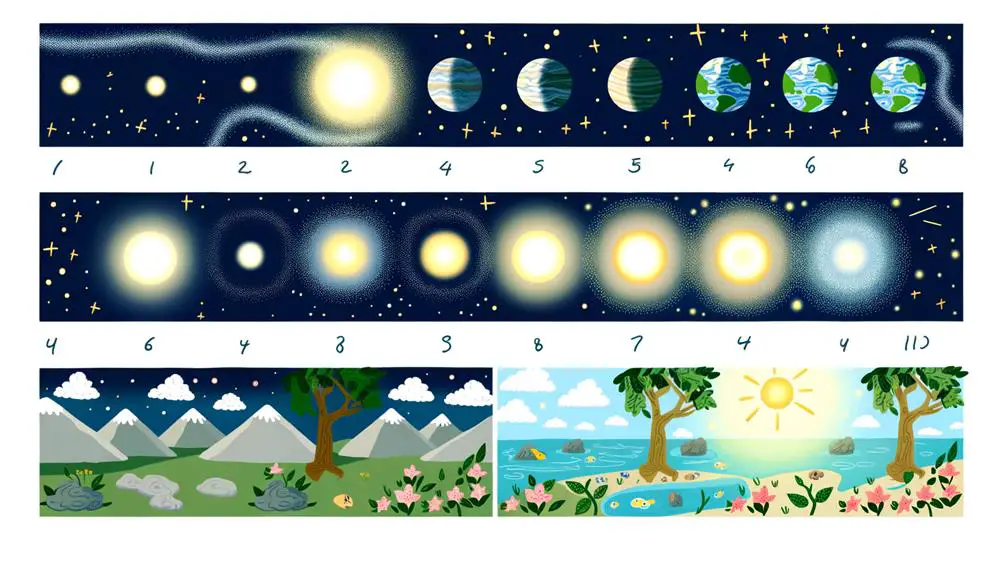Discover the cosmic intrigue woven into the Bible's pages, where celestial bodies illuminate divine mysteries begging to be explored.

Space in the Bible
When you explore the celestial tapestry woven into the fabric of the Bible, you're venturing beyond the earthly realm. From the creation narrative in Genesis to the apocalyptic visions in Revelation, the scriptures offer a unique perspective on the cosmos that's both ancient and profound.
You'll find that stars, the sun, and the moon aren't just heavenly bodies, but they play pivotal roles in biblical stories and teachings. As you embark on this journey, consider how these cosmic elements are more than mere backdrops—they're integral to understanding the biblical worldview.
Let's unravel these celestial threads together, shall we?
Key Takeaways
- The Bible portrays space as a canvas of creation, highlighting God's craftsmanship and divine majesty.
- Stars, the sun, and the moon in the Bible symbolize divine communication, guidance, and the marking of time.
- Biblical accounts use cosmic imagery to provoke reflection on divine mysteries, human suffering, and the interconnectedness of the universe.
- Revelations and prophetic visions in the Bible offer insights into the cosmic battle, the merging of heaven and earth, and a renewed creation.
The Genesis Account

Exploring the Genesis account unveils a profound depiction of space as the canvas of creation, inviting you to ponder the meticulous orchestration behind the universe's inception. This narrative isn't merely a tale; it's a scholarly exploration into the dawn of existence, where every word is laden with significance and every verse a testament to the grandeur of creation. The creation timeline, a central element in this account, provides a structured framework, detailing the sequential emergence of light, land, sea, celestial bodies, and life in a manner that's both poetic and precise.
From Adam's perspective, the universe's creation wasn't an abstract concept but an observable reality, a phenomenon he was both a witness to and a participant in. His viewpoint offers a unique lens through which you're invited to interpret the genesis of space, not as a detached observer but as a part of this divine tapestry. Adam's experience underscores the personal aspect of creation, highlighting not just the cosmic scale of this event but its intimate relevance to humanity.
This analytical journey through the Genesis account prompts you to reevaluate your understanding of space, not merely as a physical dimension but as a sacred arena where the divine and the terrestrial converge. The reverence with which this narrative treats the cosmos challenges you to look beyond the mere mechanics of creation, urging you to appreciate the profound interconnectedness and purpose imbued in the fabric of space itself.
The Firmament Explained

Delving into the concept of the firmament, Scripture often portrays it as a vast expanse, meticulously separating the waters above from those below, a pivotal act in the cosmos's divine architecture. This depiction, rich in metaphorical imagery, invites you to ponder its significance from both a scientific perspective and through the lens of cultural interpretations.
Aspect |
Explanation |
|---|---|
Scientific Perspective |
Modern science views the firmament as the atmosphere or sky, a natural barrier keeping the earth's essential elements in balance. |
Cultural Interpretations |
Various cultures have seen the firmament as a solid dome or vault, symbolizing the divine separation between celestial and terrestrial realms. |
Biblical Context |
In Scripture, the firmament is presented as God's craftsmanship, a testament to the Creator's power and the structured nature of the universe. |
From a scientific standpoint, you're encouraged to see the firmament not as a literal physical structure but as an allegorical representation of the sky and atmosphere, crucial for life on Earth. This understanding bridges ancient textual descriptions with contemporary scientific knowledge, showcasing the Bible's enduring relevance.
Culturally, the firmament's depiction has evolved, reflecting humanity's growing comprehension of the world. Initially conceived as a solid dome, this interpretation has shifted towards a more symbolic understanding, emphasizing the Creator's sovereignty and meticulous order in the universe's design.
This analytical exploration of the firmament reveals its multifaceted role: a divine boundary, a symbol of God's omnipotence, and a bridge between ancient wisdom and modern science. It's a testament to the Bible's layered meanings, inviting continuous discovery and reflection.
Stars in Biblical Times

Having examined the firmament's role as a divine separator of realms, let's now turn our attention to the stars, which illuminate the biblical night sky with profound symbolism and meaning. In the scriptures, stars aren't merely celestial bodies; they're imbued with spiritual significance, serving as signs, guides, and symbols of divine promise. Here's how stars play a pivotal role in biblical times:
- Guidance: Stars were used as navigational tools, guiding travelers and shepherds. The most famous example is the Star of Bethlehem, which led the Magi to the birthplace of Jesus. This demonstrates how stars, in their divine role, direct paths both physically and spiritually.
- Divine Communication: Throughout the Bible, stars often symbolize the communication between God and humanity. Astronomical alignments, for instance, are seen as signs from the divine, marking significant events and seasons.
- Representation of Angels: In several passages, stars metaphorically represent angels or celestial beings. This symbolism underscores the interconnectedness of the cosmos and the spiritual realm, highlighting a celestial hierarchy that mirrors divine order.
- Naming and Ownership: The act of naming stars and assigning them roles within the biblical narrative (e.g., the “morning stars” in Job) signifies not only an awareness of astronomical phenomena but also a deeper understanding of their significance. Star names in the Bible often carry with them stories of faith, prophecy, and divine will.
The Sun, Moon, and Signs

Beyond the stars, the sun and moon serve as powerful symbols in the Bible, marking time and declaring God's glory to the world. They're not just celestial bodies; they're divine instruments, deeply intertwined with human history and spirituality. The Bible incorporates them in stories, prophecies, and teachings, transcending their astronomical roles.
You'll find that lunar festivals and solar myths are embedded in biblical narratives, signifying times of worship, reflection, and prophecy. The Passover, for instance, is determined by the lunar cycle, highlighting the moon's significance in determining sacred times. Similarly, solar imagery is prevalent in descriptions of God's power and majesty, often likened to the brilliance and life-giving force of the sun.
Symbol |
Significance |
|---|---|
Sun |
Represents God's glory, guidance, and the promise of salvation. |
Moon |
Marks time and symbolizes the rhythm of life and festivity. |
Solar Eclipses |
Often interpreted as omens or signs from God, indicating significant events. |
Lunar Phases |
Guide the scheduling of festivals and holy days, linking worship with the cosmos. |
Constellations |
Viewed as signs from God, providing direction and insight to the faithful. |
This table conveys the deeper meanings of these celestial phenomena, showcasing their integral role in biblical teachings and the lives of believers. The sun and moon are not merely objects in the sky; they are signs, imbued with spiritual significance. Through them, the Bible communicates God's omnipotence and the interconnectedness of all creation, urging you to look beyond the physical and into the divine realm.
Visions of Heaven

In the scripture, visions of heaven reveal a realm beyond human comprehension, offering glimpses into the divine majesty and eternal home prepared for believers. These visions, recorded by prophets, serve as profound elements of faith, demonstrating the interconnectedness of heaven and Earth, and the grandeur of God's kingdom. Notably, Ezekiel's Wheels and Isaiah's Throne stand as significant representations, each embodying unique aspects of divine revelation and the nature of the heavenly realm.
To keep you engaged, consider these four pivotal elements drawn from biblical visions of heaven:
- Ezekiel's Wheels (Ezekiel 1:4-28): This vision portrays a complex heavenly chariot, symbolizing God's mobility and omnipresence. The intricate details and the description of the 'wheels within wheels,' adorned with eyes, emphasize God's all-seeing nature and the profound mystery surrounding His divine governance.
- Isaiah's Throne (Isaiah 6:1-3): Here, the prophet Isaiah witnesses the Lord seated on a high and exalted throne, the hem of His robe filling the temple. This vision underscores God's sovereignty and holiness, with seraphim proclaiming, 'Holy, holy, holy is the Lord Almighty; the whole earth is full of his glory.'
- The Multifaceted Symbolism: Both visions are rich with symbolism, from the creatures surrounding Ezekiel's chariot to the seraphim in Isaiah's vision, each element serves to convey aspects of God's character and the heavenly realm's incomprehensible splendor.
- Theological Implications: These visions offer deep insights into God's nature, His omnipotence, and the ultimate hope of salvation and eternal life for believers.
Analyzing these visions reveals the depth of the Bible's portrayal of heaven, inviting believers to ponder the majesty and mystery of God's eternal kingdom.
Job's Cosmic Queries

Several passages within the Book of Job pose profound questions about the cosmos, directly challenging our understanding of the universe's divine intricacies and God's governance over it. Job's lamentations and inquiries into the nature of his suffering invite a Divine dialogue that stretches beyond personal or earthly concerns, touching upon cosmic suffering and the very structure of the universe. Through these exchanges, you're drawn into a contemplative space where the vastness of creation and the intimate details of divine governance are explored.
You'll find that Job's cosmic queries don't just seek answers; they provoke a deeper reflection on humanity's place within the universe and the relationship between the Creator and creation. This dialogue between Job and the Divine opens up a space for pondering the mysteries of suffering, justice, and the order of the cosmos. It's a conversation that doesn't offer easy answers but instead, enriches our understanding of divine wisdom and sovereignty.
Moreover, these passages underscore the significance of cosmic suffering within the wider narrative of divine-human interaction. They encourage you to consider how suffering, both personal and cosmic, fits into the larger tapestry of God's creation and governance. Through Job's inquiries, you're invited into a reverent contemplation of the universe's complexities and the mysteries of divine purpose.
Ultimately, Job's Cosmic Queries serve as a testament to the enduring human quest for understanding in the face of the unfathomable. They remind you that divine dialogue can offer profound insights into our existence and the universe's grand design, even when definitive answers remain elusive.
The Psalms: Celestial Praise

As you explore the Psalms, you encounter a rich tapestry of verses that elevate the heavens into a realm of divine worship.
The stars and celestial bodies aren't merely physical entities, but participants in a cosmic chorus praising God's glory.
This poetic portrayal invites a deeper appreciation of the universe as a testament to divine majesty.
Stars Singing God's Glory
The Psalms poetically depict the stars as celestial beings that sing God's glory, inviting readers to reflect on the vastness of the universe and its creator. This imagery isn't just about visual splendor; it's also about auditory symbolism, where cosmic music becomes a metaphor for divine harmony. Consider the following aspects:
- Cosmic Music: The concept of the stars singing praises highlights the universe's role in worshiping its Creator through celestial harmony.
- Auditory Symbolism: This metaphor extends beyond literal sound, symbolizing universal acknowledgment of divine sovereignty.
- Spiritual Reflection: Encourages contemplation on one's place within this grand cosmic chorus.
- Divine Glory: Emphasizes the stars' role in manifesting God's majesty, showcasing a universe orchestrated for His praise.
Through such vivid imagery, the Psalms enrich our spiritual and cosmic understanding.
Heavenly Bodies Worship
Why do the Psalms portray heavenly bodies as entities that worship the Creator through their existence and movements? The Psalms, steeped in reverence, suggest a universe where every celestial body, from stars to moons, serves a dual purpose: to light the night sky and to honor their Maker. This depiction warns against idolatry, highlighting the consequences of venerating the creation over the Creator.
Modern interpretations extend this reverence to a call for environmental stewardship, seeing in the Psalms a reminder of humanity's role in preserving the divine order.
Aspect |
Biblical Reference |
Modern Interpretation |
|---|---|---|
Sun |
Psalm 19:4-6 |
Solar stewardship |
Moon |
Psalm 104:19 |
Lunar cycles |
Stars |
Psalm 148:3 |
Cosmic wonder |
Earth |
Psalm 96:11-12 |
Environmental care |
Sea |
Psalm 69:34 |
Ocean preservation |
Revelations and the Cosmos

In exploring Revelations, one finds that its vivid imagery and prophetic visions offer a unique perspective on the cosmos, encouraging readers to consider the universe's spiritual dimensions. This book of the Bible isn't just about the end times; it's a portal into understanding how the spiritual and cosmic realms intertwine. Revelations invites you to delve deeper into the mysteries of the universe, challenging you to see beyond the physical world.
Here are four key themes that highlight the cosmic aspect of Revelations:
- Cosmic Battles: Revelations depict battles that transcend our earthly understanding, suggesting that the struggle between good and evil extends across the cosmos. Such narratives might even hint at the presence of extraterrestrial life, involved in these spiritual wars.
- Heavenly Realms: It introduces us to a celestial kingdom, not just as a distant paradise but as a real dimension that influences earthly events. This heavenly realm is intricately connected with the happenings of our universe.
- Prophetic Stars: Stars aren't just celestial bodies; they're used symbolically to represent angels or divine messages. Revelations encourage us to view the night sky with wonder and as a source of divine revelation.
- The New Jerusalem: This concept presents a merging of heaven and earth, a new cosmos where the divine presence is fully realized. It's a vision that combines physical space with spiritual significance, offering hope for a renewed creation.
Through these themes, Revelations paints a picture of the cosmos that's both awe-inspiring and deeply spiritual, urging you to consider the universe's grandeur and mystery from a perspective of faith.
Frequently Asked Questions
How Do Modern Space Discoveries Align or Conflict With Biblical Descriptions of the Cosmos?
You're exploring how modern space discoveries either complement or challenge traditional views of the cosmos. These advances often stretch beyond historical cosmology, bringing cosmic metaphors into new light.
While some findings might seem at odds with ancient texts, they also offer opportunities to deepen our understanding, blending reverence with analysis.
It's a fascinating intersection where science and spirituality dialogue, inviting you to re-examine age-old beliefs in the light of contemporary celestial discoveries.
Are There Any Biblical References That Could Be Interpreted as Describing Other Planets or Extraterrestrial Life?
You're delving into a complex realm, where celestial metaphors meet ancient astronaut theories.
In your quest, you'll find the Bible doesn't explicitly mention other planets or extraterrestrial life. However, its rich tapestry of imagery and allegories invites interpretation.
Scholars and enthusiasts alike speculate on verses that could hint at cosmic phenomena beyond Earth. This intersection of divine narrative and cosmic exploration enriches both your understanding and reverence for the unknown.
How Have Interpretations of the Bible's Cosmic Imagery Evolved With Advancements in Astronomy?
As you delve into how interpretations of cosmic metaphors in religious texts have transformed, you'll find that advancements in astronomy deeply influence these shifts.
Historically, people viewed celestial descriptions through the lens of their current scientific understanding. Now, with modern astronomy offering a broader view of the cosmos, scholars reexamine these passages, integrating new discoveries with historical context.
This evolution reflects a fascinating intersection between faith, science, and the ever-expanding universe.
What Role Do Angels and Other Spiritual Beings Play in the Structure and Governance of the Biblical Cosmos?
You're opening a can of worms when delving into the role of angels in the biblical cosmos. The angelic hierarchy isn't just a celestial chain of command; it's a framework for understanding spiritual warfare and divine governance.
These spiritual beings, from archangels to guardian angels, play pivotal roles in executing God's will and battling against dark forces. This intricate structure reflects a deeply reverent and analytical view of the universe's spiritual dimension.
How Have Different Christian Denominations Interpreted the Concept of "The Heavens" in Light of Space Exploration?
Different Christian denominations have varied in their interpretations of 'the heavens' with the advent of space exploration. Historical perspectives provide a foundation for these interpretations, while ecumenical dialogues have sought common ground.
You'll find that some view space as God's creation, marveling at its vastness and mystery. Others focus on theological implications, pondering how humanity's reach into the cosmos aligns with divine will. It's a fascinating blend of faith, science, and wonder.
Conclusion
As you've journeyed through the cosmic tapestry woven within the Bible, you've encountered a universe brimming with divine mystery and majesty. From the Genesis narrative to the celestial visions in Revelation, the Bible serves not only as a spiritual compass but also as a celestial map, guiding us through the heavens.
Like stars scattered across the night sky, each verse illuminates our understanding of the cosmos, inviting us to gaze upward in awe and reverence at God's infinite creation.



Sign up